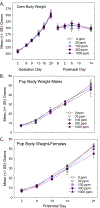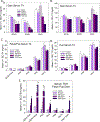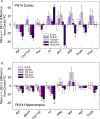Ammonium perchlorate: serum dosimetry, neurotoxicity, and resilience of the neonatal rat thyroid system
- PMID: 38145495
- PMCID: PMC11588387
- DOI: 10.1093/toxsci/kfad133
Ammonium perchlorate: serum dosimetry, neurotoxicity, and resilience of the neonatal rat thyroid system
Erratum in
-
Correction: Ammonium perchlorate: serum dosimetry, neurotoxicity, and resilience of the neonatal rat thyroid system.Toxicol Sci. 2024 Feb 28;198(1):155-156. doi: 10.1093/toxsci/kfae010. Toxicol Sci. 2024. PMID: 38308820 No abstract available.
Abstract
The environmental contaminant perchlorate impairs the synthesis of thyroid hormones by reducing iodine uptake into the thyroid gland. Despite this known action, moderate doses of perchlorate do not significantly alter serum thyroid hormone in rat pups born to exposed dams. We examined perchlorate dosimetry and responsivity of the thyroid gland and brain in offspring following maternal exposure to perchlorate. Pregnant rat dams were delivered perchlorate in drinking water (0, 30, 100, 300, 1000 ppm) from gestational day 6 to postnatal day (PN) 21. Perchlorate was present in the placenta, milk, and serum, the latter declining in pups over the course of lactation. Serum and brain thyroid hormone were reduced in pups at birth but recovered to control levels by PN2. Dramatic upregulation of Nis was observed in the thyroid gland of the exposed pup. Despite the return of serum thyroid hormone to control levels by PN2, expression of several TH-responsive genes was altered in the PN14 pup brain. Contextual fear learning was unimpaired in the adults, supporting previous reports. Declining levels of serum perchlorate and a profound upregulation of Nis gene expression in the thyroid gland are consistent with the rapid return to the euthyroid state in the neonate. However, despite this recovery, thyroid hormone insufficiencies in serum and brain beginning in utero and present at birth appear sufficient to alter TH action in the fetus and subsequent trajectory of brain development. Biomarkers of that altered trajectory remain in the brain of the neonate, demonstrating that perchlorate is not devoid of effects on the developing brain.
Keywords: AOP; brain; development; neurotoxicity; perchlorate; thyroid hormone.
Published by Oxford University Press on behalf of the Society of Toxicology 2023.
Figures









Similar articles
-
Structural Malformations in the Neonatal Rat Brain Accompany Developmental Exposure to Ammonium Perchlorate.Toxics. 2023 Dec 18;11(12):1027. doi: 10.3390/toxics11121027. Toxics. 2023. PMID: 38133428 Free PMC article.
-
Gestational Exposure to Perchlorate in the Rat: Thyroid Hormones in Fetal Thyroid Gland, Serum, and Brain.Toxicol Sci. 2022 Jun 28;188(1):117-130. doi: 10.1093/toxsci/kfac038. Toxicol Sci. 2022. PMID: 35385113 Free PMC article.
-
Changes in cross-fostered Sprague-Dawley rat litters exposed to perchlorate.Int J Toxicol. 2003 Mar-Apr;22(2):87-94. doi: 10.1080/10915810305088. Int J Toxicol. 2003. PMID: 12745989
-
Interference on Iodine Uptake and Human Thyroid Function by Perchlorate-Contaminated Water and Food.Nutrients. 2020 Jun 4;12(6):1669. doi: 10.3390/nu12061669. Nutrients. 2020. PMID: 32512711 Free PMC article.
-
Environmental exposure to perchlorate: A review of toxicology and human health.Toxicol Appl Pharmacol. 2018 Nov 1;358:102-109. doi: 10.1016/j.taap.2018.09.001. Epub 2018 Sep 2. Toxicol Appl Pharmacol. 2018. PMID: 30184474 Review.
Cited by
-
Structural Malformations in the Neonatal Rat Brain Accompany Developmental Exposure to Ammonium Perchlorate.Toxics. 2023 Dec 18;11(12):1027. doi: 10.3390/toxics11121027. Toxics. 2023. PMID: 38133428 Free PMC article.
-
Iodine Deficiency Exacerbates Thyroidal and Neurological Effects of Developmental Perchlorate Exposure in the Neonatal and Adult Rat.Toxics. 2024 Nov 23;12(12):842. doi: 10.3390/toxics12120842. Toxics. 2024. PMID: 39771057 Free PMC article.
-
Prenatal test cohort of a modified rat comparative thyroid assay adding brain thyroid hormone measurements and histology but lowering group size appears able to detect disruption by sodium phenobarbital.Curr Res Toxicol. 2024 Apr 18;6:100168. doi: 10.1016/j.crtox.2024.100168. eCollection 2024. Curr Res Toxicol. 2024. PMID: 38693933 Free PMC article.
-
Suppression of Hippocampal Neurogenesis and Oligodendrocyte Maturation Similar to Developmental Hypothyroidism by Maternal Exposure of Rats to Ammonium Perchlorate, a Gunpowder Raw Material and Known Environmental Contaminant.Environ Toxicol. 2025 Jan;40(1):30-53. doi: 10.1002/tox.24413. Epub 2024 Sep 9. Environ Toxicol. 2025. PMID: 39248596 Free PMC article.
References
-
- Abt E, Spungen J, Pouillot R, Gamalo-Siebers M, Wirtz M. 2018. Update on dietary intake of perchlorate and iodine from u.S. Food and drug administration’s total diet study: 2008–2012. J Expo Sci Environ Epidemiol. 28(1):21–30. - PubMed
-
- Bernal J 2017. Thyroid hormone regulated genes in cerebral cortex development. The Journal of endocrinology. 232(2):R83–r97. - PubMed
-
- Blount BC, Valentin-Blasini L. 2006. Analysis of perchlorate, thiocyanate, nitrate and iodide in human amniotic fluid using ion chromatography and electrospray tandem mass spectrometry. Anal Chim Acta. 567(1):87–93. - PubMed
MeSH terms
Substances
Grants and funding
LinkOut - more resources
Full Text Sources

